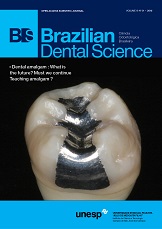Analysis of flexural strength of composite resins polymerized by 2nd and 3rd generation leds
DOI:
https://doi.org/10.14295/bds.2015.v18i1.1073Resumo
Objective: This study aimed to investigate the mechanical properties of three composite resins using 2nd and 3rd generation LED-based light-curing devices. Material and Methods: Sixty specimens distributed according to the type of resin(Group Z350 - nanoparticle composite resin [Filtek Z350 / 3M ESPE]; Group AP - microhybrid composite Amelogen Plus/Ultradent; Group DF - Group composite resin Durafil l/Heraeus Kulzer), and the light-curing device(Group 2ndG - 2nd generation LED-based curing unit at power density of 500 mW / cm2; Group 3rdG - 3rd generation LED-based curing unit at power density of 1100 MW/cm2).The specimens were stored in a dark, dry container at 37 °C in an incubator for 24 h and submitted to the mini-flexural test on universal test machine (EMIC) to determine the elastic modulus and flexural strength using a three-point test.The data were submitted to two-way ANOVA (Resin Composite X LED) and Tukey test (5%).Results: Concerning to flexural strength (in MPa), ANOVA showed significant in Tukey test for the interaction between the factors: Group Z350/3rdG - 105.36a; Group AP/3rdG – 81.49ab; Group DF/3rdG – 66.43bc; Group AP/2ndG – 66.13bc; Group DF/2ndG: 60.61bc; Group Z350/2ndG: 47,19c. With regard to the modulus of elasticity (in GPa), the results obtained were: Factor resin composite - Group Z350 (8.85a) > Group AP (7.61b) > Group DF (1.94c); Factor LED - Group 3rdG (7.13a) > Group 2ndG (5.14b). Conclusion:It was concluded that the 3rd generation LED (1100 mw/cm2) significant increased the means of the flexural properties of composites. It was also concluded that the result of flexural properties of compositesdepends on the resin material tested.
Keywords: Composite resin; Flexural strength; Modulus of elasticity.
Downloads
Downloads
Publicado
Como Citar
Edição
Seção
Licença
TRANSFERÊNCIA DE DIREITOS AUTORAIS E DECLARAÇÃO DE RESPONSABILIDADE
Toda a propriedade de direitos autorais do artigo "____________________________________________________________________" é transferido do autor(es) para a CIÊNCIA ODONTOLÓGICA BRASILEIRA, no caso do trabalho ser publicado. O artigo não foi publicado em outro lugar e não foi submetido simultaneamente para publicação em outra revista.
Vimos por meio deste, atestar que trabalho é original e não apresenta dados manipulados, fraude ou plágio. Fizemos contribuição científica significativa para o estudo e estamos cientes dos dados apresentados e de acordo com a versão final do artigo. Assumimos total responsabilidade pelos aspectos éticos do estudo.
Este texto deve ser impresso e assinado por todos os autores. A versão digitalizada deverá ser apresentada como arquivo suplementar durante o processo de submissão.




























